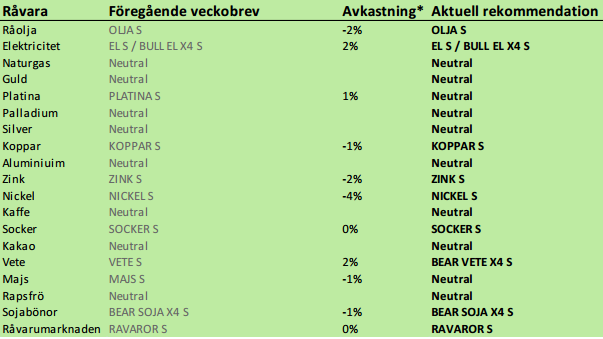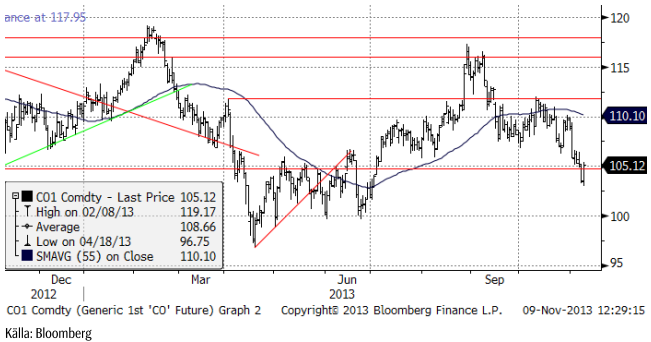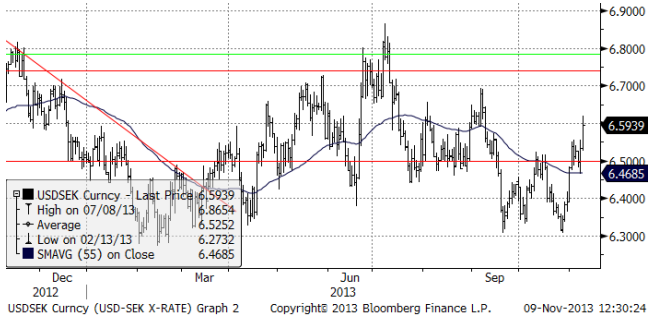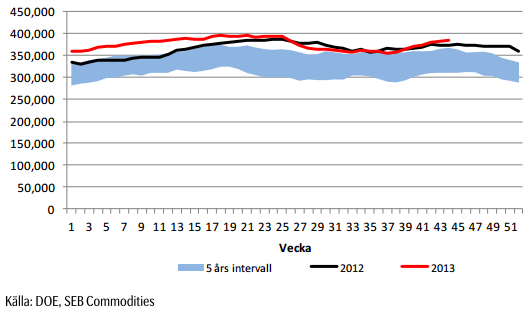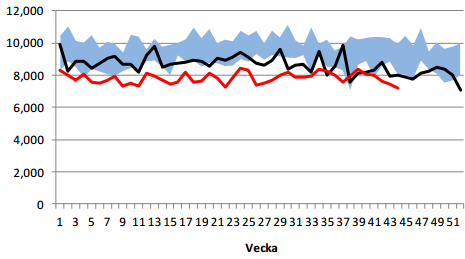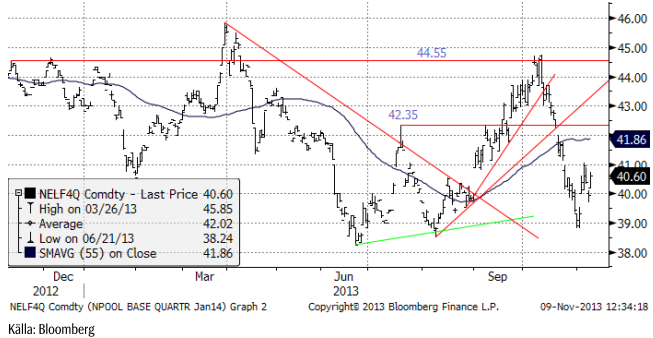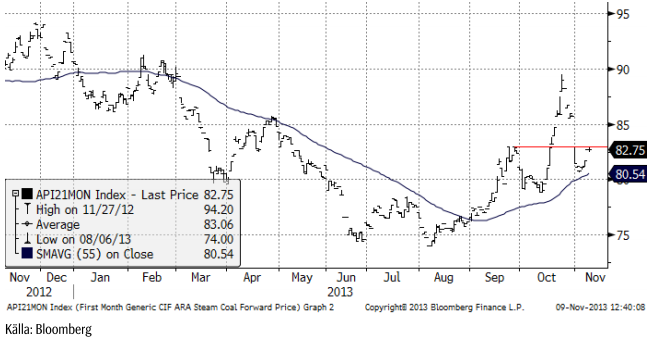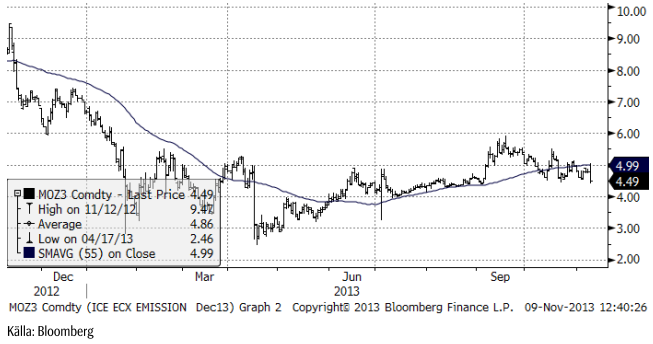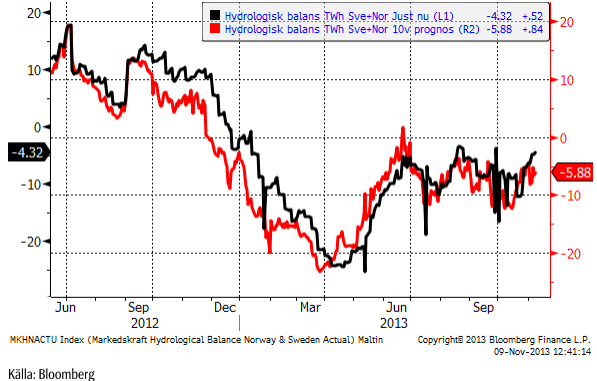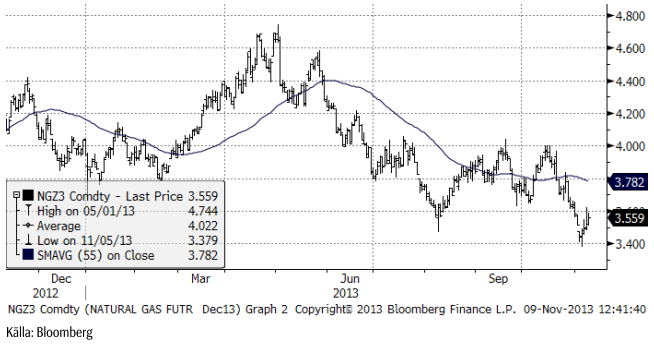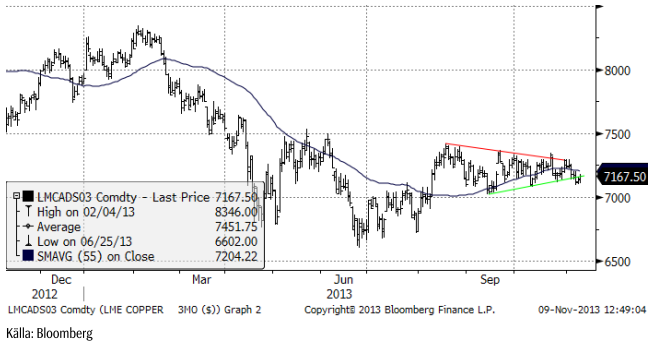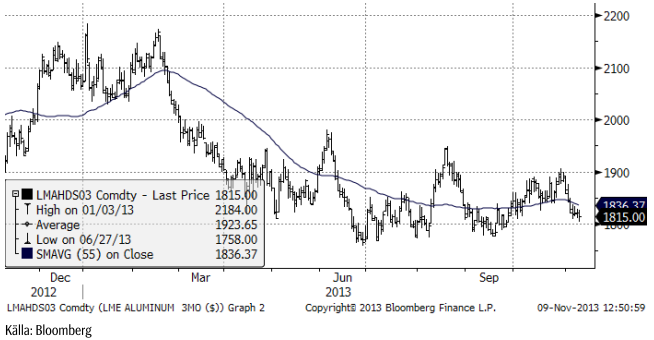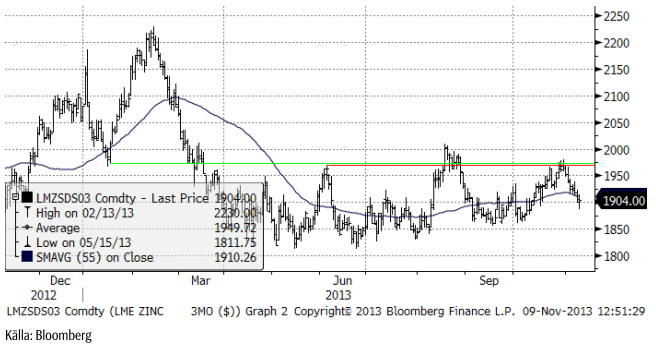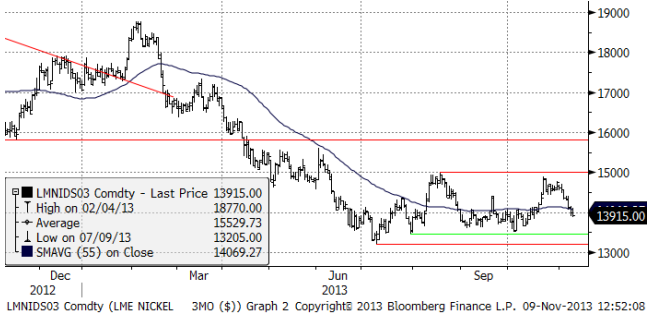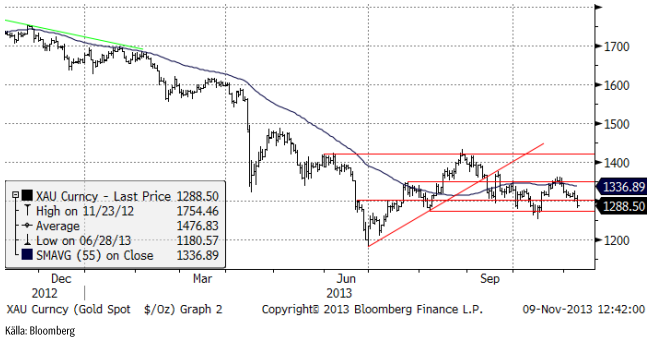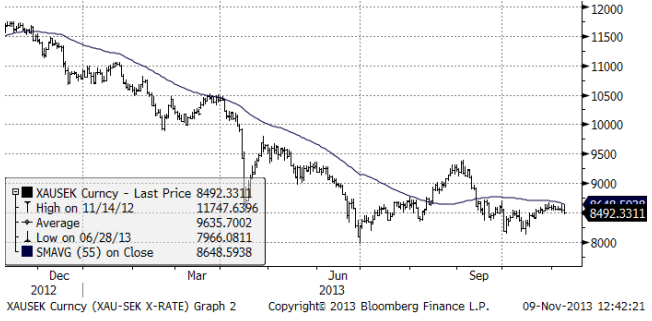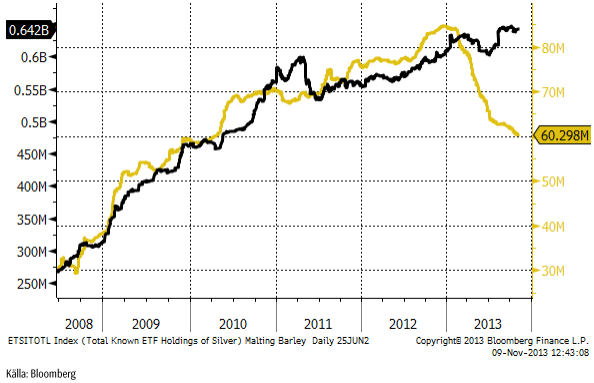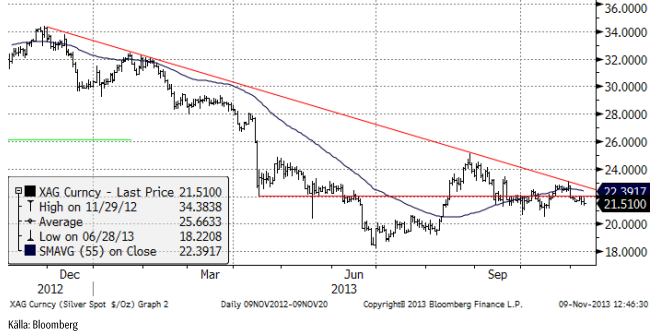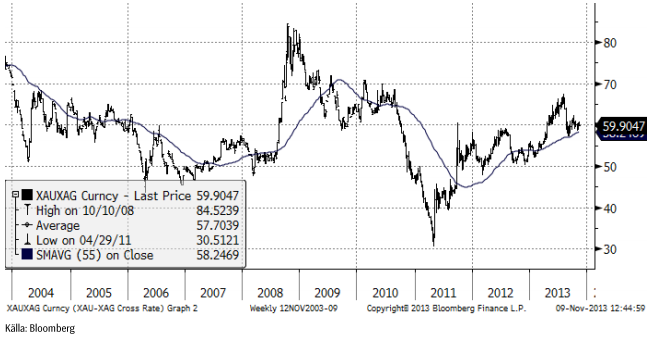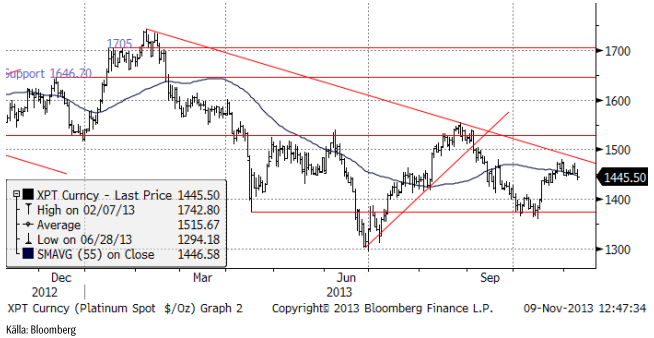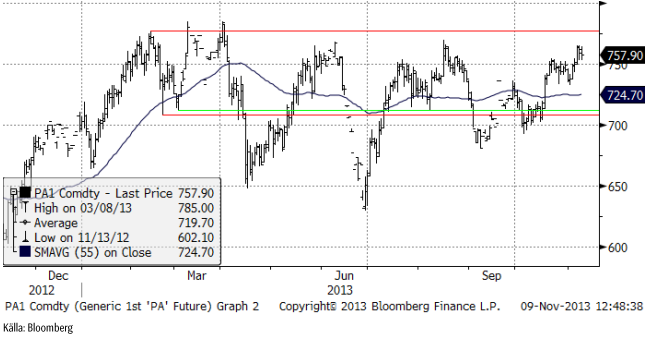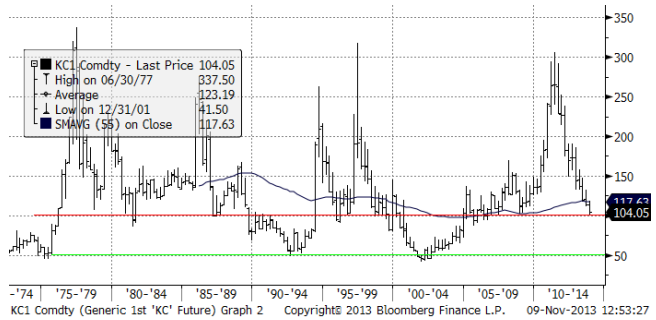Analys
SEB – Råvarukommentarer, 11 november 2013

Rekommendationer
*) Avkastningen anges för 1:1 certifikaten där både BULL och 1:1 certifikat är angivna.
Inledning
I veckan som gick har flera stora händelser inträffat och rapporter av stor betydelse för råvarumarknaden har publicerats. ECB:s räntesänkning och starkare BNP och arbetsmarknadsstatistik från USA fick dollarn att stärkas i veckan – och euron och kronan att falla. Naturligtvis ledde ett högre pris på dollarn att råvaror noterade i dollar sjönk i motsvarande grad. Råvaror noterade i euro, eller omräknade till kronor höll sig stabila. På jordbrukssidan publicerade FAO / AMIS sin månadsrapport, som inte hade någon större inverkan på marknaden. Förväntningarna om ett riktigt fyrverkeri var inställda på USDA:s månatliga WASDE-rapport, som inte kommit ut på två månader. Det blev något av ett antiklimax när den väl kom klockan 18 i fredags. Efter en viss tvekan valde marknaden att handla upp majs och soja på basis av vad rapporten sade om den amerikanska marknaden. Ser vi till de globala utbuds- och efterfrågebalanserna är det inte lika uppenbart att priset ska upp.
Ny information medför att vi gjort flera revideringar av våra rekommendationer, framförallt pga WASDE-rapporten. Vi går över till neutral vy på majspriset och från köp till sälj på vete. Vi behåller sälj på sojabönor. Vi går också över från köp till neutral på platina och palladium (en försiktig köp i förra veckobrevet).
USA firar idag vapenstilleståndet i det första världskriget (klockan 11), omdöpt till ”Veteran’s Day”, men börserna är öppna. Det kan därför bli lite tunnare handel idag måndag, än vanligt.
Råolja – Brent
Oljepriset backade med 1% i veckan, efter att ha handlats på ännu lägre nivåer i torsdags. Oljeprisfallet på 1% ska ses mot bakgrund av att dollarn stärktes mot såväl euron som kronan med 1%. I dessa valutor var alltså oljepriset oförändrat.
Nedanför ser vi kursutvecklingen på dollar mot kronor. Europeiska valutor, inklusive den svenska kronan, föll direkt efter ECB:s i och för sig väntade sänkning av styrräntan till 0.25%. Dollarn styrka fick sedan ytterligare skjuts när arbetsmarknadsstatistiken i USA visade att över 200,000 människor fått nytt jobb under oktober månad. Detta trots budgetbråket och stängningen av den amerikanska federala staten under månaden. En starkare dollar betyder automatiskt lägre noteringar på råvaror, när de uttrycks i dollar.
I onsdagens DOE-rapport steg råoljelagren för sjunde veckan på raken. Lagren ökade med 1.5 miljoner fat till 385 miljoner. Lagernivåerna ligger nu återigen på rekordnivåer för den här tiden på året, högre än förra året.
Lagerökningen i USA har skett trots att importen har minskat till 7.2 miljoner fat. Samma vecka förra året importerades 8 miljoner fat per dag. Detta har alltså substituerats med inhemsk produktion. Det höga priset på olja håller alltså på att stimulera fram mer produktion. Det är ett tydligt tecken på att pris och inte resonemanget om ”ändliga resurser” spelar en avgörande roll för hur mycket som produceras.
Det växande utbudet av råolja är en långsiktigt negativ faktor för oljemarknaden. Den kompenserande faktorn är rabatten på terminerna, som gör att en investering i olja trots allt kan vara långsiktigt lönsam. Förra veckan varnade vi att ”den som är intresserad kanske bör avvakta med köp ifall priset faller i veckan”. Vi anser att vi har haft det prisfallet och att det nu är säkrare att öka positionen i olja genom OLJA S.
Elektricitet
Elpriset, som föll när det blöta väder vi nu upplever började dyka upp i prognoserna, fann stöd på 39 euro per MWh och handlades upp till 41 euro. I torsdags fick vinsthemtagningar priset på fall, men handeln i fredags var stark. Marknaden kommer antagligen att testa 41 euro igen. Ovanför finns nästa motstånd vid 42.35 euro.
Nedan ser vi prisdiagrammet för det första kvartalet 2014:s kontrakt, uppdaterat till i fredags.
Nedan ser vi priset på energikol, den närmaste månadens leveranstermin. Priset har utvecklats stark i veckan. Priset ligger nu strax under ett kortsiktigt motstånd. Trenden är uppåtriktad, vilket ges av högre toppar och högre bottnar, samt att 55-dagars glidande medelvärde är stigande.
Utsläppsrätterna utvecklar sig däremot svagare, som vi ser i prisdiagrammet för decemberkontraktet på utsläppsrätter nedan. Marknaden var betydligt svagare i fredags än förväntat.
Hydrologisk balans har inte stigit så mycket som man kunde tro av allt regnande. Nederbörden har kommit på befolkningscentra och inte på högre höjder i norr, i samma utsträckning.
Vi rekommenderar köp av EL S eller BULL EL X4 S.
Naturgas
Naturgaspriset fann stöd på 3.40 och vände upp till 3.60, ett tekniskt motstånd. Trenden är nedåtriktad och enligt teknisk analys, är det mer troligt att priset vänder ner efter veckans uppgång, än att priset fortsätter upp.
Metaller
Veckans huvudtema har varit dollarns styrka å ena sidan och eurons och kronans å den andra. De amerikanska siffrorna fortsätter att överraska på uppsidan, i veckan både med BNP och NFP. Detta ökar i sin tur en eventuell start av nedtrappning av den monetära stimulansen i USA redan i december eller åtminstone tidigare än diskonterats. ECB sänkte som väntat (men uppenbarligen som en överraskning för några) styrräntan till 0.25%. Detta gav också en försvagning av europeiska valutor och en förstärkning av dollarn i veckan. ECB gjorde detta eftersom inflationen så tydligt är på väg nedåt och för att arbetslösheten i EU är så hög och ”hållbar”.
Så nu är vi i den något förvirrande situationen, där starka siffror i USA är negativt för metallpriserna, såsom uttryckta i dollar. Som vi har sagt tidigare att vi tror att detta är en kortsiktig effekt och att tillväxtutsikterna kommer att ta över, förr eller senare . Ännu viktigare för metallefterfrågan är naturligtvis Kina, varifrån vi såg viss uppmuntrande handelsstatistik. Viktigast var högre export, vilket är en indikation på bättre efterfrågan utanför Kina. I helgen började kommunistpartiet fyra dagars plenum, vilket förväntas ge information om hur ledarskapet kommer att stödja konjunkturen.
I Genève gör helgens förhandlingar om Irans nukleära program framsteg i skrivande stund . Ett avtal skulle ha en potentiellt baissig effekt på oljepriset, även om de inledande samtalen mellan parterna redan har gett ett negativt bidrag till oljeprisets utveckling de senaste veckorna.
Koppar
Koppar kunde inte stå emot den starka dollarn och priserna testade den nedre delen av intervallet i veckan som gick. Det såg ut som det skulle vara ett allvarligt test på nedsidan, men den tekniskt föranledda försäljningen blev väl absorberad av handelns intresse. Den kinesiska handelsbalansen i veckan visade en nedgång i importen av raffinerad koppar och halvfabrikat med 11% från föregående månad. Detta var dock inte oväntat på grund av den tidigare höga importen av koncentrat (som med befintlig raffinaderikapacitet lätt skulle kunna producera tillräckligt av koppar). Statistik i lördags visade en högre industriproduktion än väntat och att inflationen låg inom regeringens mål, bör ge stöd till marknaden den kommande veckan.
Aluminium
LME har godkänt de föreslagna ändringarna i sin lagerverksamhet för att minska köerna. Dessutom har LME meddelat vissa ändringar av förslaget. Minskningen i köerna siktar nu på att komma ner till 50 snarare än 100 kalenderdagar. Dessutom kommer LME att utreda och agera för att motiverka lagerhusföretagens incitament, som bidrar till att det bildas kö för att hämta ut material från lagren. LME har också sagt att de kommer att beställa en fullständig extern logistisk översyn av LME:s lagersystem.
Den samlade bedömningen efter tillkännagivandet var åt det baissiga hållet, speciellt när det gäller den fysiska premien (över LME:s börspris). Det finns dock diskussioner om att lagerhållarna kommer att öka hyran som kompensation! När det gäller priset skulle man kunna resonera att om LME:s förändringar gör det lättare att få ut tidigare ”låst” material, kan det leda till prispress. De flesta bedömare påpekar doch att så länge räntorna är låga och det är contango i terminsmarknaden, kommer materialet bara att flyttas till andra lager.
Dollarns styrka under veckan har satt tydlig press på priset (noterat i dollar). Efter fredagens NFP testades det långsiktiga stödet vid $ 1800, men det höll. Vi anser att stödet är tillräckligt starkt för att hålla marknaden i prisintervallet $ 1800 – $ 1900.
Vi har neutral rekommendation.
Zink
Det finns inte så mycket att rapportera om zink den här veckan. Priset följde den allmänna trenden och avslutar veckan med ett allvarligt test av nedsidan i det senaste prisintervallet. Tekniskt bestod marknaden ett styrkeprov i fredags när det tekniska stödet på $ 1886 testades ”spot on”, för att följas av ett ”upp-ställ” vid stängningen.
Nickel
Nickel föll kraftigare än resten av basmetallkomplexet under veckan som gick. Prisintervallet är bredare för nickel än för de andra basmetallerna, liksom volatiliteten i priset. Med det överskott som finns, kan man inte utesluta risken för ett test till på nedsidan. Men mot bakgrund av den allmänna bedömningen av marknaden för industrimetaller, tror vi att många kommer att passa på att köpa om ett gynnsamt pris skulle komma.
Vi anser att marknaden redan har diskonterat en kompromisslösning beträffande den indonesiska exporten eller exportförbudet, när den ska träda i kraft nästa år. En online ”survey” gjord av Metal Bulletin i frågan, visade att 44% av de svarande väntade sig en höjning av exportskatten istället för ett totalförbud. 26% ansåg att exportförbudet kommer att skjutas upp. 21% tror att exportförbudet kommer att införas, som beslutat, medan 9% av de svarande inte tror att den indonesiska regeringen kommer att förhindra exportmöjligheterna alls. Vi får alltså tolka dessa svar från industriella aktörer på marknaden, som att en stor majoritet av dem tror att utbudet av billig laterit nickelmalm kommer att fortsätta vara tillgänglig på ett eller annat sätt.
Vår grundsyn att man bör försöka köpa nickel och rekommenderar köp av NICKEL S, i synnerhet om priset kommer ner mot 13,500 dollar per ton. Priset (cash och 3 månaders termin, som vi alltid avser), går att följa på www.basemetals.com
Guld & Silver
Guldpriset (i dollar) har de senaste månaderna handlats i ett intervall mellan 1250 och 1350. Med den senaste veckans starka dollar har priset (såsom noterat i dollar) fallit och stängde nästan på dagslägsta i fredags, som också var den svagaste handelsdagen för guld under veckan.
I termer av kronor, har priset hållit sig stabilt, med endast marginella prisrörelser under veckan. Vi ser kursdiagrammet på priset i kronor för ett troy uns nedan. Notera att vi inte har någon teknisk köpsignal, men vi har ett tekniskt stöd vid 8000 kr. Trenden är fortfarande nedåtriktad.
I diagrammet nedan ser vi antalet uns som innehas av börshandlade fonder. Den gula kurvan avser guld och den svarta silver. Vi ser att investerare fortsätter att likvidera sina likvida börshandlade fonder på guld. I och för sig är det anmärkningsvärt att priset inte faller, trots att säljtrycket från investerare är så starkt. I klassisk litteratur om marknadsanalys, finns resonemang om vad som händer efter ett stort kursfall. Det sägs att ägandet flyttas från ”svaga händer” till ”starka” i en process som kallas för ”konsolidering”. Det är möjligt att det är detta som håller på att ske nu. Många som köpt börshandlade fonder på guld har kanske gjort det utan särskilt mycket annan analys än att priset verkar gå upp (dvs tidigare) och nu säljer de för att priset verkar gå ner.
Nedan ser vi kursdiagrammet för silver i dollar per troy ounce. Vi noterar att den fallande trendlinjen / motståndet från toppen för ett år sedan, inte har brutits och att marknaden inte lyckades bryta igenom den. När sådana test misslyckas brukar det ofta leda till besvikelse, med kursfall som följd.
Silver handlas i relation till guld på 59.9, dvs guld är 59.9 gånger dyrare per uns än silver. Det är en hög nivå i ett historiskt perspektiv och ett resultat av allmänt fallande priset på guld och silver. Silver tar alltid ut svängarna mer än vad guld gör. Om prisnedgången fortsätter finns alltså risk att silver faller mer än guld och att silver blir ännu billigare i det historiska perspektivet.
Vi fortsätter att vara neutrala guld och silver.
Platina & Palladium
SEB:s certifikat PLATINA S steg med 1% i veckan och PALLADIUM S steg med 4%. Tekniskt ser vi att platina hittills inte lyckats gå igenom den fallande motstånds/trendlinjen. Risken för besvikelse är uppenbar.
Detsamma gäller marknaden för palladium, som utvecklats mycket starkt den senaste tiden. Priset är uppe på nivåer i toppen på på det prisintervall som varit rådande det senaste året. Den kortsiktiga trenden är uppåtriktad, men motstånden kan få den trenden att ta slut.
Pga de motstånd som finns, väljer vi att i alla fall för tillfället gå över till neutral rekommendation på platina och palladium.
Kaffe
Kaffepriset föll ner mot 100 cent per pund i veckan, men fick stöd där. Nivån 100% har de senaste 40 åren varit en stödnivå. När priset kommit uppifrån har trenden i regel vänt upp. Räkna gärna själv hur många gånger det har hänt!
Den absoluta bottennivån har dock legat på 50 cent, vilket är ett djup som förskräcker om man köpt strax över 100.
Vi tror dock att det kan komma en rekyl från den här nivån, som åtminstone bör kunna ta upp priset till 150 cent. Eftersom trenden ännu inte vänt, vill vi dock inte rekommendera konkret ”köp”.
Nedan ser vi det senaste årets prisutveckling i mars-kontraktet på arabica i New York. Flera marknadsbedömare har tyckt sig känna igen den ”blow-out” som ofta sker när de sista tappar sugen, i den senaste tidens nedgång från 120 till 105 cent.
Vi behåller tills vidare neutral rekommendation, tills vi ser tecken på ett trendbrott.
[box]SEB Veckobrev Veckans råvarukommentar är producerat av SEB Merchant Banking och publiceras i samarbete och med tillstånd på Råvarumarknaden.se[/box]
Disclaimer
The information in this document has been compiled by SEB Merchant Banking, a division within Skandinaviska Enskilda Banken AB (publ) (“SEB”).
Opinions contained in this report represent the bank’s present opinion only and are subject to change without notice. All information contained in this report has been compiled in good faith from sources believed to be reliable. However, no representation or warranty, expressed or implied, is made with respect to the completeness or accuracy of its contents and the information is not to be relied upon as authoritative. Anyone considering taking actions based upon the content of this document is urged to base his or her investment decisions upon such investigations as he or she deems necessary. This document is being provided as information only, and no specific actions are being solicited as a result of it; to the extent permitted by law, no liability whatsoever is accepted for any direct or consequential loss arising from use of this document or its contents.
About SEB
SEB is a public company incorporated in Stockholm, Sweden, with limited liability. It is a participant at major Nordic and other European Regulated Markets and Multilateral Trading Facilities (as well as some non-European equivalent markets) for trading in financial instruments, such as markets operated by NASDAQ OMX, NYSE Euronext, London Stock Exchange, Deutsche Börse, Swiss Exchanges, Turquoise and Chi-X. SEB is authorized and regulated by Finansinspektionen in Sweden; it is authorized and subject to limited regulation by the Financial Services Authority for the conduct of designated investment business in the UK, and is subject to the provisions of relevant regulators in all other jurisdictions where SEB conducts operations. SEB Merchant Banking. All rights reserved.
Analys
Tightening fundamentals – bullish inventories from DOE

The latest weekly report from the US DOE showed a substantial drawdown across key petroleum categories, adding more upside potential to the fundamental picture.

Commercial crude inventories (excl. SPR) fell by 5.8 million barrels, bringing total inventories down to 415.1 million barrels. Now sitting 11% below the five-year seasonal norm and placed in the lowest 2015-2022 range (see picture below).
Product inventories also tightened further last week. Gasoline inventories declined by 2.1 million barrels, with reductions seen in both finished gasoline and blending components. Current gasoline levels are about 3% below the five-year average for this time of year.
Among products, the most notable move came in diesel, where inventories dropped by almost 4.1 million barrels, deepening the deficit to around 20% below seasonal norms – continuing to underscore the persistent supply tightness in diesel markets.
The only area of inventory growth was in propane/propylene, which posted a significant 5.1-million-barrel build and now stands 9% above the five-year average.
Total commercial petroleum inventories (crude plus refined products) declined by 4.2 million barrels on the week, reinforcing the overall tightening of US crude and products.


Analys
Bombs to ”ceasefire” in hours – Brent below $70

A classic case of “buy the rumor, sell the news” played out in oil markets, as Brent crude has dropped sharply – down nearly USD 10 per barrel since yesterday evening – following Iran’s retaliatory strike on a U.S. air base in Qatar. The immediate reaction was: “That was it?” The strike followed a carefully calibrated, non-escalatory playbook, avoiding direct threats to energy infrastructure or disruption of shipping through the Strait of Hormuz – thus calming worst-case fears.

After Monday morning’s sharp spike to USD 81.4 per barrel, triggered by the U.S. bombing of Iranian nuclear facilities, oil prices drifted sideways in anticipation of a potential Iranian response. That response came with advance warning and caused limited physical damage. Early this morning, both the U.S. President and Iranian state media announced a ceasefire, effectively placing a lid on the immediate conflict risk – at least for now.
As a result, Brent crude has now fallen by a total of USD 12 from Monday’s peak, currently trading around USD 69 per barrel.
Looking beyond geopolitics, the market will now shift its focus to the upcoming OPEC+ meeting in early July. Saudi Arabia’s decision to increase output earlier this year – despite falling prices – has drawn renewed attention considering recent developments. Some suggest this was a response to U.S. pressure to offset potential Iranian supply losses.
However, consensus is that the move was driven more by internal OPEC+ dynamics. After years of curbing production to support prices, Riyadh had grown frustrated with quota-busting by several members (notably Kazakhstan). With Saudi Arabia cutting up to 2 million barrels per day – roughly 2% of global supply – returns were diminishing, and the risk of losing market share was rising. The production increase is widely seen as an effort to reassert leadership and restore discipline within the group.
That said, the FT recently stated that, the Saudis remain wary of past missteps. In 2018, Riyadh ramped up output at Trump’s request ahead of Iran sanctions, only to see prices collapse when the U.S. granted broad waivers – triggering oversupply. Officials have reportedly made it clear they don’t intend to repeat that mistake.
The recent visit by President Trump to Saudi Arabia, which included agreements on AI, defense, and nuclear cooperation, suggests a broader strategic alignment. This has fueled speculation about a quiet “pump-for-politics” deal behind recent production moves.
Looking ahead, oil prices have now retraced the entire rally sparked by the June 13 Israel–Iran escalation. This retreat provides more political and policy space for both the U.S. and Saudi Arabia. Specifically, it makes it easier for Riyadh to scale back its three recent production hikes of 411,000 barrels each, potentially returning to more moderate increases of 137,000 barrels for August and September.
In short: with no major loss of Iranian supply to the market, OPEC+ – led by Saudi Arabia – no longer needs to compensate for a disruption that hasn’t materialized, especially not to please the U.S. at the cost of its own market strategy. As the Saudis themselves have signaled, they are unlikely to repeat previous mistakes.
Conclusion: With Brent now in the high USD 60s, buying oil looks fundamentally justified. The geopolitical premium has deflated, but tensions between Israel and Iran remain unresolved – and the risk of missteps and renewed escalation still lingers. In fact, even this morning, reports have emerged of renewed missile fire despite the declared “truce.” The path forward may be calmer – but it is far from stable.
Analys
A muted price reaction. Market looks relaxed, but it is still on edge waiting for what Iran will do

Brent crossed the 80-line this morning but quickly fell back assigning limited probability for Iran choosing to close the Strait of Hormuz. Brent traded in a range of USD 70.56 – 79.04/b last week as the market fluctuated between ”Iran wants a deal” and ”US is about to attack Iran”. At the end of the week though, Donald Trump managed to convince markets (and probably also Iran) that he would make a decision within two weeks. I.e. no imminent attack. Previously when when he has talked about ”making a decision within two weeks” he has often ended up doing nothing in the end. The oil market relaxed as a result and the week ended at USD 77.01/b which is just USD 6/b above the year to date average of USD 71/b.

Brent jumped to USD 81.4/b this morning, the highest since mid-January, but then quickly fell back to a current price of USD 78.2/b which is only up 1.5% versus the close on Friday. As such the market is pricing a fairly low probability that Iran will actually close the Strait of Hormuz. Probably because it will hurt Iranian oil exports as well as the global oil market.
It was however all smoke and mirrors. Deception. The US attacked Iran on Saturday. The attack involved 125 warplanes, submarines and surface warships and 14 bunker buster bombs were dropped on Iranian nuclear sites including Fordow, Natanz and Isfahan. In response the Iranian Parliament voted in support of closing the Strait of Hormuz where some 17 mb of crude and products is transported to the global market every day plus significant volumes of LNG. This is however merely an advise to the Supreme leader Ayatollah Ali Khamenei and the Supreme National Security Council which sits with the final and actual decision.
No supply of oil is lost yet. It is about the risk of Iran closing the Strait of Hormuz or not. So far not a single drop of oil supply has been lost to the global market. The price at the moment is all about the assessed risk of loss of supply. Will Iran choose to choke of the Strait of Hormuz or not? That is the big question. It would be painful for US consumers, for Donald Trump’s voter base, for the global economy but also for Iran and its population which relies on oil exports and income from selling oil out of that Strait as well. As such it is not a no-brainer choice for Iran to close the Strait for oil exports. And looking at the il price this morning it is clear that the oil market doesn’t assign a very high probability of it happening. It is however probably well within the capability of Iran to close the Strait off with rockets, mines, air-drones and possibly sea-drones. Just look at how Ukraine has been able to control and damage the Russian Black Sea fleet.
What to do about the highly enriched uranium which has gone missing? While the US and Israel can celebrate their destruction of Iranian nuclear facilities they are also scratching their heads over what to do with the lost Iranian nuclear material. Iran had 408 kg of highly enriched uranium (IAEA). Almost weapons grade. Enough for some 10 nuclear warheads. It seems to have been transported out of Fordow before the attack this weekend.
The market is still on edge. USD 80-something/b seems sensible while we wait. The oil market reaction to this weekend’s events is very muted so far. The market is still on edge awaiting what Iran will do. Because Iran will do something. But what and when? An oil price of 80-something seems like a sensible level until something do happen.
-

 Nyheter4 veckor sedan
Nyheter4 veckor sedanStor uppsida i Lappland Guldprospekterings aktie enligt analys
-

 Nyheter4 veckor sedan
Nyheter4 veckor sedanSilverpriset släpar efter guldets utveckling, har mer uppsida
-

 Nyheter3 veckor sedan
Nyheter3 veckor sedanUppgången i oljepriset planade ut under helgen
-

 Nyheter3 veckor sedan
Nyheter3 veckor sedanLåga elpriser i sommar – men mellersta Sverige får en ökning
-

 Nyheter2 veckor sedan
Nyheter2 veckor sedanMahvie Minerals växlar spår – satsar fullt ut på guld
-

 Analys3 veckor sedan
Analys3 veckor sedanVery relaxed at USD 75/b. Risk barometer will likely fluctuate to higher levels with Brent into the 80ies or higher coming 2-3 weeks
-

 Nyheter1 vecka sedan
Nyheter1 vecka sedanOljan, guldet och marknadens oroande tystnad
-

 Nyheter1 vecka sedan
Nyheter1 vecka sedanJonas Lindvall är tillbaka med ett nytt oljebolag, Perthro, som ska börsnoteras


